Chirality Sensing of Amino Acid Esters by S-2-Methylbutanamido-Substituted m-Phthalic Diamide-Linked Zinc Bisporphyrinate
Abstract
:1. Introduction
2. Results and Discussion
2.1. Characterization of [Zn2(S-MAABis)]
2.1.1. Analysis of NMR Spectra
2.1.2. Crystal Structure of [Zn4(MAABis)2(H2O)]
2.2. Chirality Sensing and Recognition of Amino Acid Esters by [Zn2(S-MAABis)]
2.2.1. CD Spectra upon Complexation of Zinc Bisporphyrinate with Amino Acid Esters
2.2.2. NMR Studies
2.2.3. UV–Vis Spectrophotometric Titration
2.2.4. Computational Studies
3. Materials and Methods
3.1. General
3.2. Synthesis
3.2.1. Synthesis of 5-(S-2-Methylbutanamido)-Isophthalic Acid Diamide-Linked Bisporphyrin H4(S-MAABis)
3.2.2. Synthesis of Zinc Bisporphyrinate [Zn2(S-MAABis)]
3.2.3. Synthesis and Crystal Growth of Zinc Bisporphyrinate [Zn2(MAABis)]
3.3. Computation Methods
3.4. Single-Crystal X-ray Crystallography
4. Conclusions
Supplementary Materials
Author Contributions
Funding
Institutional Review Board Statement
Informed Consent Statement
Data Availability Statement
Conflicts of Interest
References
- Lu, H.; Kobayashi, N. Optically Active Porphyrin and Phthalocyanine Systems. Chem. Rev. 2016, 116, 6184–6261. [Google Scholar] [CrossRef] [PubMed]
- Liu, M.H.; Zhang, L.; Wang, T.Y. Supramolecular Chirality in Self-Assembled Systems. Chem. Rev. 2015, 115, 7304–7397. [Google Scholar] [CrossRef] [PubMed]
- Wolf, C.; Bentley, K.W. Chirality sensing using stereodynamic probes with distinct electronic circular dichroism output. Chem. Soc. Rev. 2013, 42, 5408–5424. [Google Scholar] [CrossRef] [PubMed]
- Berova, N.; Pescitelli, G.; Petrovic, A.G.; Proni, G. Probing molecular chirality by CD-sensitive dimeric metalloporphyrin hosts. Chem. Commun. 2009, 40, 5958–5980. [Google Scholar] [CrossRef] [PubMed]
- Hembury, G.A.; Borovkov, V.V.; Inoue, Y. Chirality-Sensing Supramolecular Systems. Chem. Rev. 2008, 108, 1–73. [Google Scholar] [CrossRef] [PubMed]
- Borovkov, V.V.; Hembury, G.A.; Inoue, Y. Origin, control, and application of supramolecular chirogenesis in bisporphyrin-based systems. Acc. Chem. Res. 2004, 37, 449–459. [Google Scholar] [CrossRef] [PubMed]
- Kurtan, T.; Nesnas, N.; Li, Y.-Q.; Huang, X.; Nakanishi, K.; Berova, N. Chiral Recognition by CD-Sensitive Dimeric Zinc Porphyrin Host. 1. Chiroptical Protocol for Absolute Configurational Assignments of Monoalcohols and Primary Monoamines. J. Am. Chem. Soc. 2001, 123, 5962–5973. [Google Scholar] [CrossRef] [PubMed]
- Hayashi, S.; Yotsukura, M.; Noji, M.; Takanami, T. Bis(zinc porphyrin) as a CD-sensitive bidentate host molecule: Direct determination of absolute configuration of mono-alcohols. Chem. Commun. 2015, 51, 11068–11071. [Google Scholar] [CrossRef]
- Crossley, M.J.; Hambley, T.W.; Mackay, L.G.; Try, A.C.; Walton, R. Porphyrin analogs of Troeger’s base: Large chiral cavities with a bimetallic binding site. J. Chem. Soc. Chem. Commun. 1995, 10, 1077–1079. [Google Scholar] [CrossRef]
- Ema, T.; Ouchi, N.; Doi, T.; Korenaga, T.; Sakai, T. Highly sensitive chiral shift reagent bearing two zinc porphyrins. Org. Lett. 2005, 7, 3985–3988. [Google Scholar] [CrossRef]
- Lu, W.; Yang, H.; Li, X.; Wang, C.; Zhan, X.; Qi, D.; Bian, Y.; Jiang, J. Chiral Discrimination of Diamines by a Binaphthalene-Bridged Porphyrin Dimer. Inorg. Chem. 2017, 56, 8223–8231. [Google Scholar] [CrossRef]
- Lu, W.; Li, L.; Yang, H.; Zhao, L.; Qi, D.; Bian, Y.; Jiang, J. Intramolecular chirality induction and intermolecular chirality modulation in BINOL bridged bisporphyrin hosts. Dye. Pigm. 2017, 137, 608–614. [Google Scholar] [CrossRef]
- Zhu, J.X.; Fu, F.F.; Zhang, Z.H.; Hu, C.J.; Wang, Y. Stoichiometry-controlled chirality inversion in the amide-linked zinc bisporphyrinates induced by amino acid esters. J. Porphyr. Phthalocyanines 2023, 27, 861–872. [Google Scholar] [CrossRef]
- Wang, J.; Zhang, Z.; Hu, C.; Wang, Y. Enantioselectivity of a tartaric acid amide linked zinc bisporphyrinate towards amino acid esters. Dye. Pigm. 2020, 176, 108223. [Google Scholar] [CrossRef]
- Hu, T.T.; Liu, T.T.; Zhang, Z.H.; Wang, Y.; Yang, Y.G.; Young, D.J.; Hu, C.J.; Lang, J.P. Precise control of chirality transfer by adjusting the alkyl substituents of guests. Dye. Pigm. 2019, 160, 692–699. [Google Scholar] [CrossRef]
- Hu, T.T.; Hu, C.J.; Wang, Y.; Young, D.J.; Lang, J.P. Stoichiometrically controlled chirality inversion in zinc bisporphyrinate-monoamine complexes. Dalton Trans. 2018, 47, 5503–5512. [Google Scholar] [CrossRef] [PubMed]
- Hu, Q.; Zhuo, C.; Wang, Y.; Hu, C.; Lang, J. Chirality Transfer from Chiral Monoamines to an m-Phthalic Diamide-Linked Zinc Bisporphyrinate with a Benzylamide Substituent. Inorg. Chem. 2017, 56, 10204–10214. [Google Scholar] [CrossRef] [PubMed]
- Han, Z.; Li, L.; Shi, B.; Fang, X.; Wang, Y.; Hu, C. Crystallographic and Spectroscopic Studies of a Host-Guest Complex Consisting of a Novel Zinc Trisporphyrinate and a Chiral Monoamine. Inorg. Chem. 2016, 55, 3730–3737. [Google Scholar] [CrossRef]
- Fang, X.S.; Han, Z.; Xu, C.L.; Li, X.H.; Wang, Y.; Hu, C.J. Discrimination between alkyl and aryl substituents of chiral monoamines by m-phthalic diamide-linked zinc bisporphyrinates. Dalton Trans. 2015, 44, 12511–12515. [Google Scholar] [CrossRef]
- Jiang, J.X.; Fang, X.S.; Liu, B.Z.; Hu, C.J. m-Phthalic Diamide-Linked Zinc Bisporphyrinate: Spontaneous Resolution of Its Crystals and Its Application in Chiral Recognition of Amino Acid Esters. Inorg. Chem. 2014, 53, 3298–3306. [Google Scholar] [CrossRef]
- Jiang, J.; Feng, Z.; Liu, B.; Hu, C.; Wang, Y. Chiral recognition of amino acid esters by a novel oxalic amide-linked bisporphyrin. Dalton Trans. 2013, 42, 7651–7659. [Google Scholar] [CrossRef] [PubMed]
- Medforth, C.J. NMR Spectroscopy of Diamagnetic Porphyrins; Academic Press: Cambridge, MA, USA, 2000; pp. 1–80. [Google Scholar]
- Borovkov, V.V.; Yamamoto, N.; Lintuluoto, J.M.; Tanaka, T.; Inoue, Y. Supramolecular chirality induction in bis(zinc porphyrin) by amino acid derivatives: Rationalization and applications of the ligand bulkiness effect. Chirality 2001, 13, 329–335. [Google Scholar] [CrossRef] [PubMed]
- Smith, K.M. Porphyrins and Metalloporphyrins; Elsevier: Amsterdam, The Netherlands, 1975. [Google Scholar]
- Mizutani, T.; Ema, T.; Yoshida, T.; Kuroda, Y.; Ogoshi, H. Recognition of α-amino acid esters by zinc porphyrin derivatives via coordination and hydrogen bonding interactions. Evidence for two-point fixation from thermodynamic and induced circular dichroism spectroscopic studies. Inorg. Chem. 1993, 32, 2072–2077. [Google Scholar] [CrossRef]
- Kuroda, Y.; Kato, Y.; Higashioji, T.; Hasegawa, J.-y.; Kawanami, S.; Takahashi, M.; Shiraishi, N.; Tanabe, K.; Ogoshi, H. Chiral Amino Acid Recognition by a Porphyrin-Based Artificial Receptor. J. Am. Chem. Soc. 1995, 117, 10950–10958. [Google Scholar] [CrossRef]
- Leggett, D.J. Computational Methods for the Determination of Formation Constants; Plenum: New York, NY, USA, 1985. [Google Scholar]
- Otto, K.E.; Hesse, S.; Wassermann, T.N.; Rice, C.A.; Suhm, M.A.; Stafforst, T.; Diederichsen, U. Temperature-dependent intensity anomalies in amino acid esters: Weak hydrogen bonds in protected glycine, alanine and valine. Phys. Chem. Chem. Phys. 2011, 13, 14119–14130. [Google Scholar] [CrossRef] [PubMed]
- HyperChem (TM) Professional 8.0.10; Hypercube, Inc.: Gainesville, FL, USA, 2011.
- Frisch, M.J.; Trucks, G.W.; Schlegel, H.B.; Scuseria, G.E.; Robb, M.A.; Cheeseman, J.R.; Scalmani, G.; Barone, V.; Mennucci, B.; Petersson, G.A.; et al. Gaussian 09 Revision C.01; Gaussian: Wallingford, CT, USA, 2010. [Google Scholar]
- Dolomanov, O.V.; Bourhis, L.J.; Gildea, R.J.; Howard, J.A.K.; Puschmann, H. OLEX2: A complete structure solution, refinement and analysis program. J. Appl. Crystallogr. 2009, 42, 339–341. [Google Scholar] [CrossRef]
- Sheldrick, G.M. SHELXT—Integrated space-group and crystal-structure determination. Acta Crystallogr. Sect. A 2015, 71, 3–8. [Google Scholar] [CrossRef]
- Sheldrick, G.M. Crystal structure refinement with SHELXL. Acta Crystallogr. Sect. C-Struct. Chem. 2015, 71, 3–8. [Google Scholar] [CrossRef]
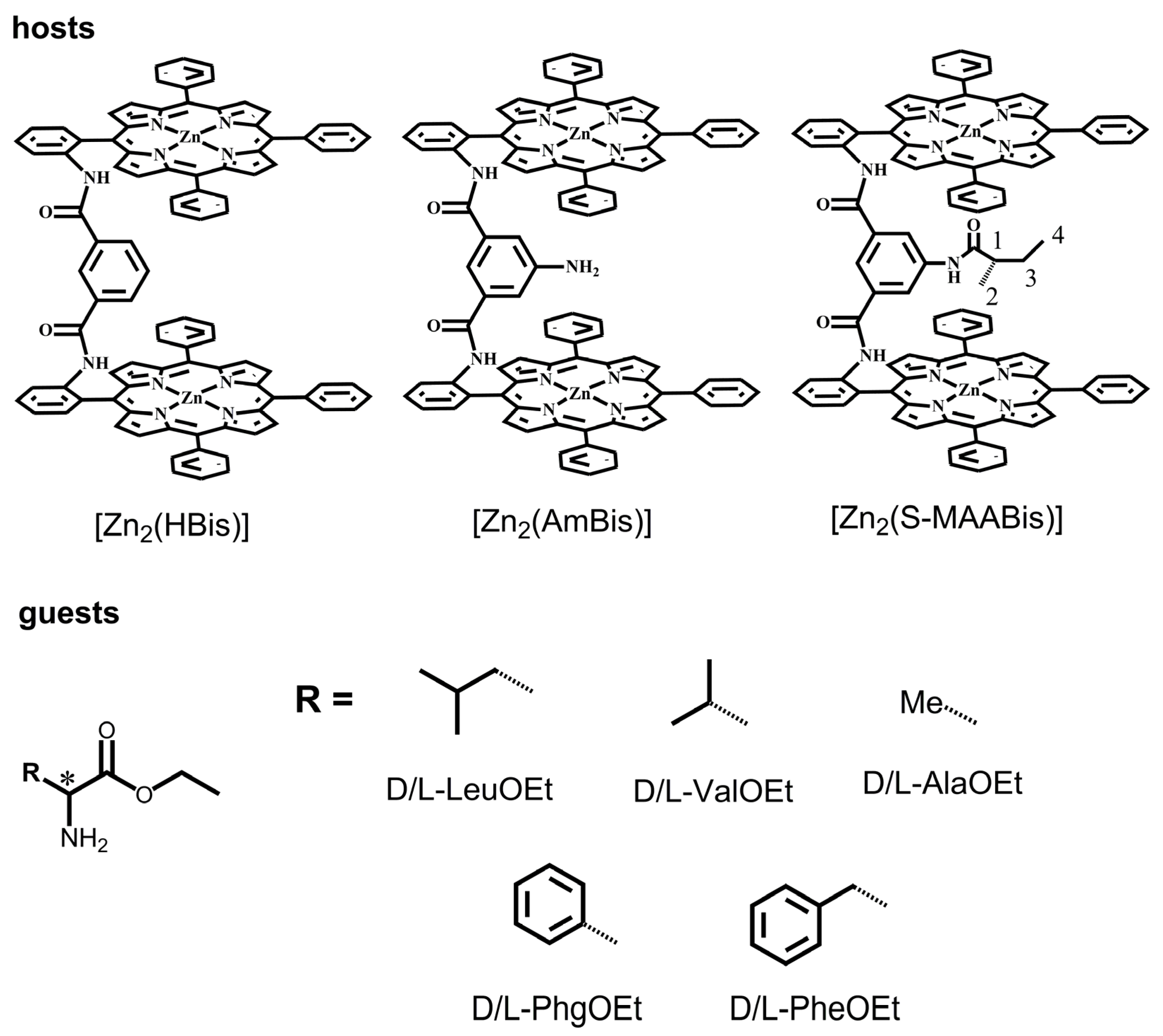

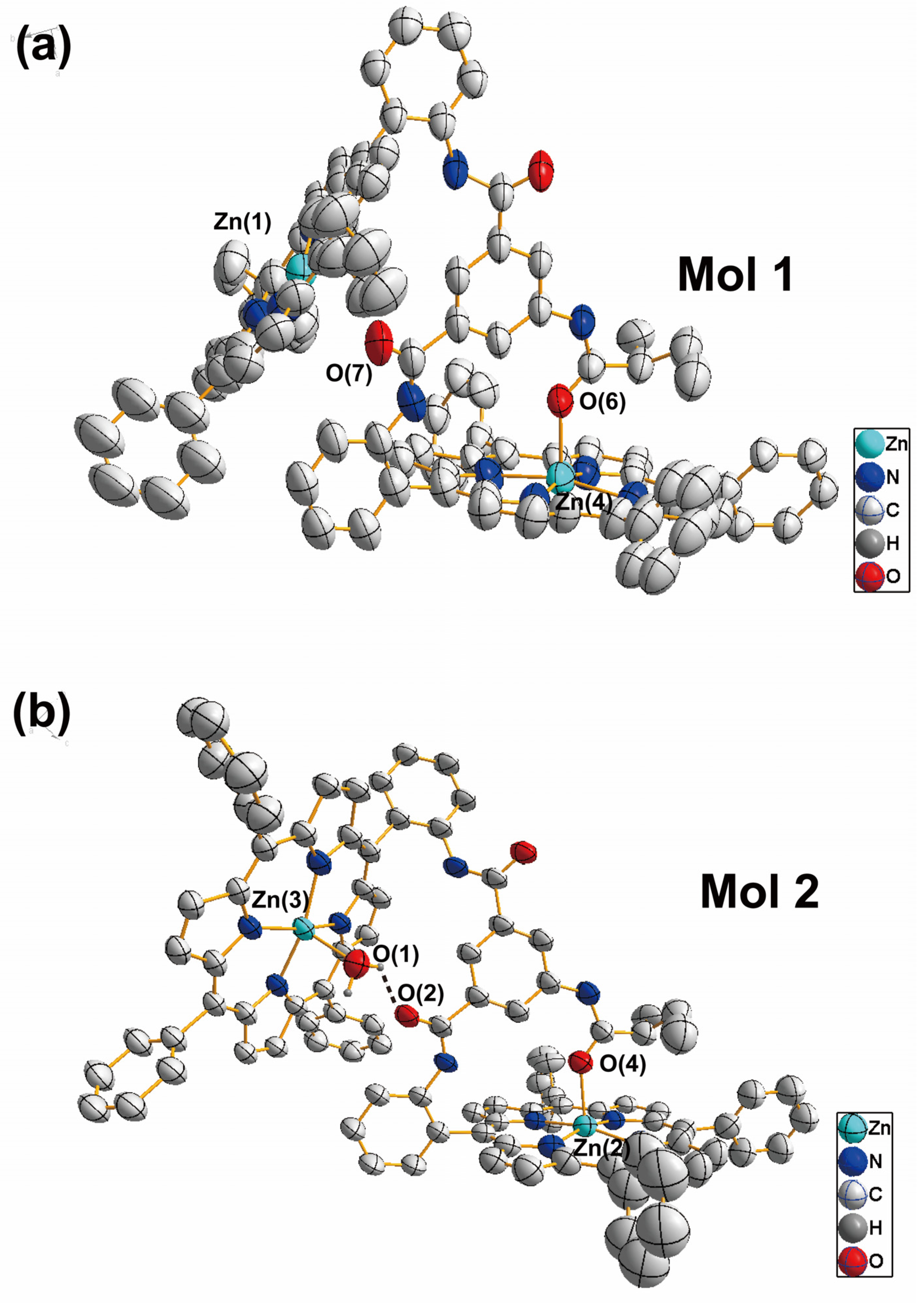
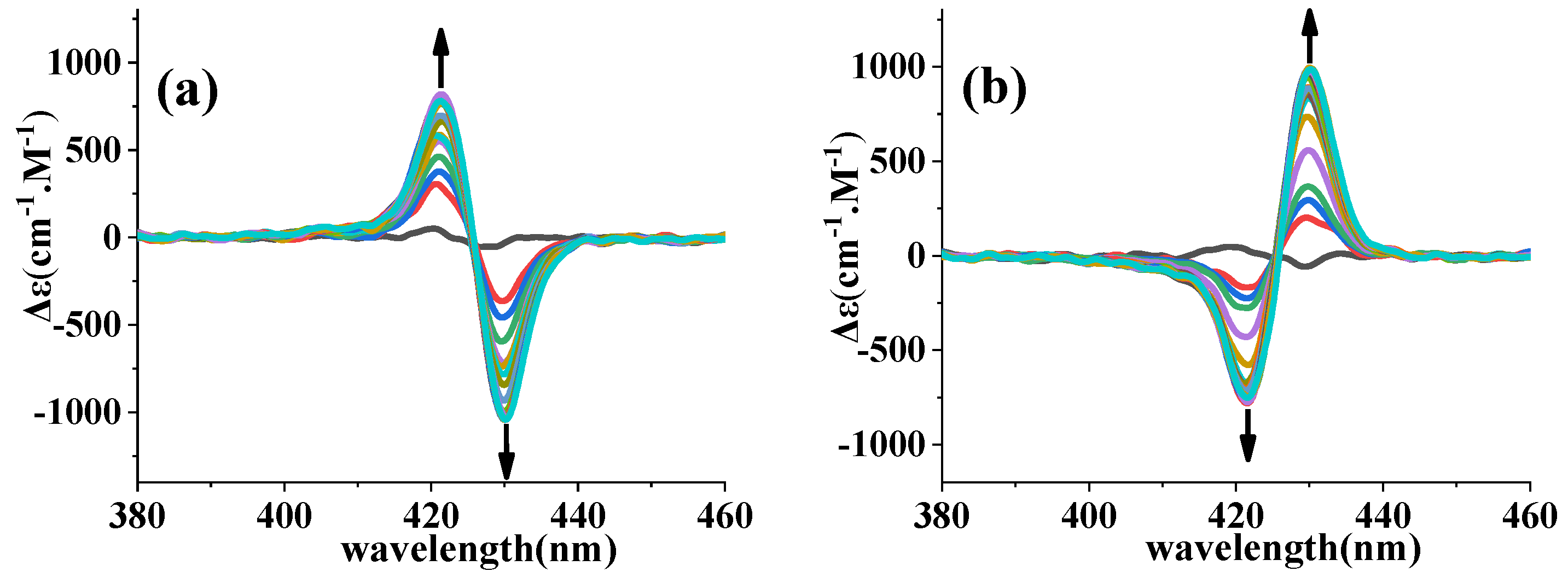
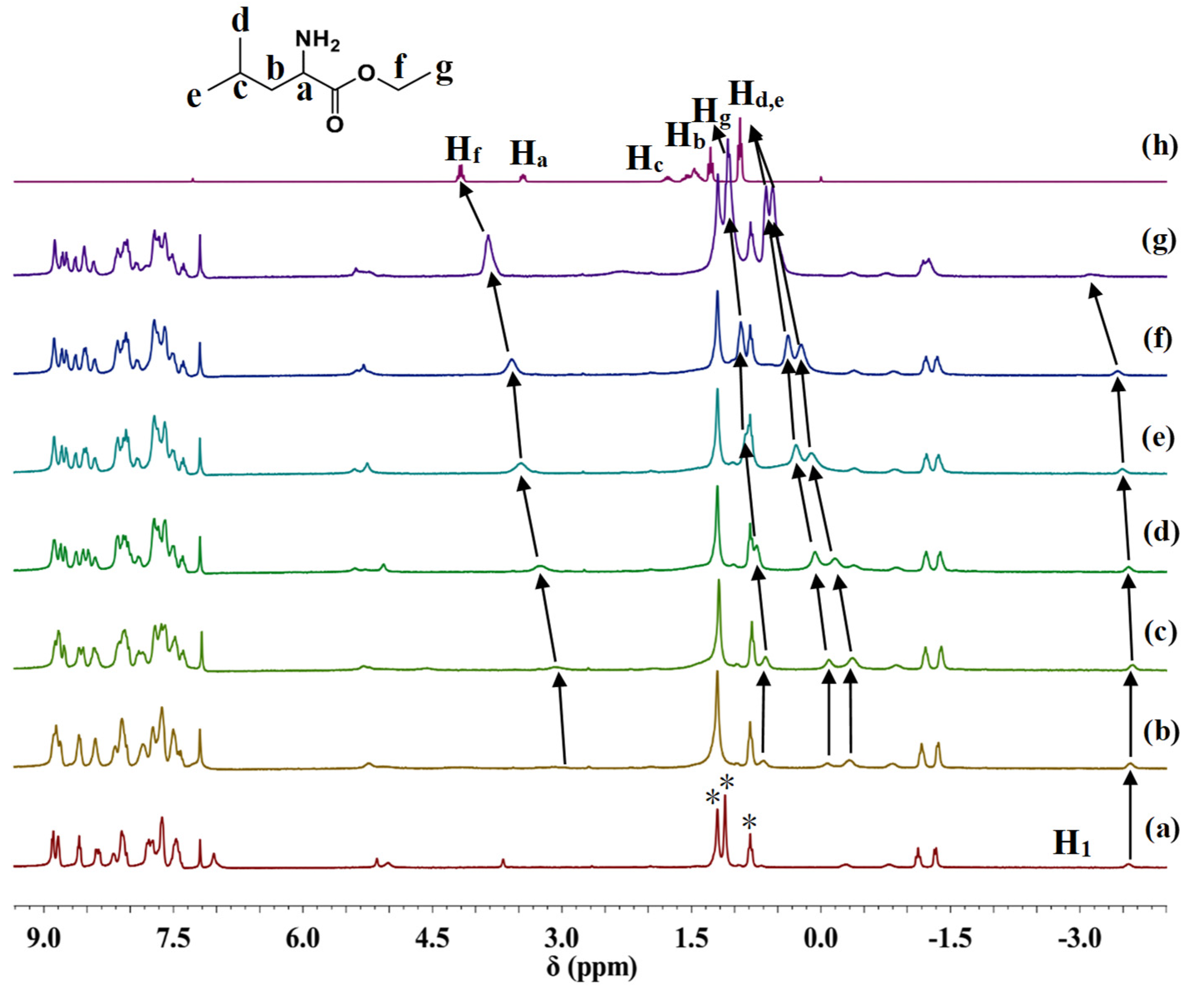

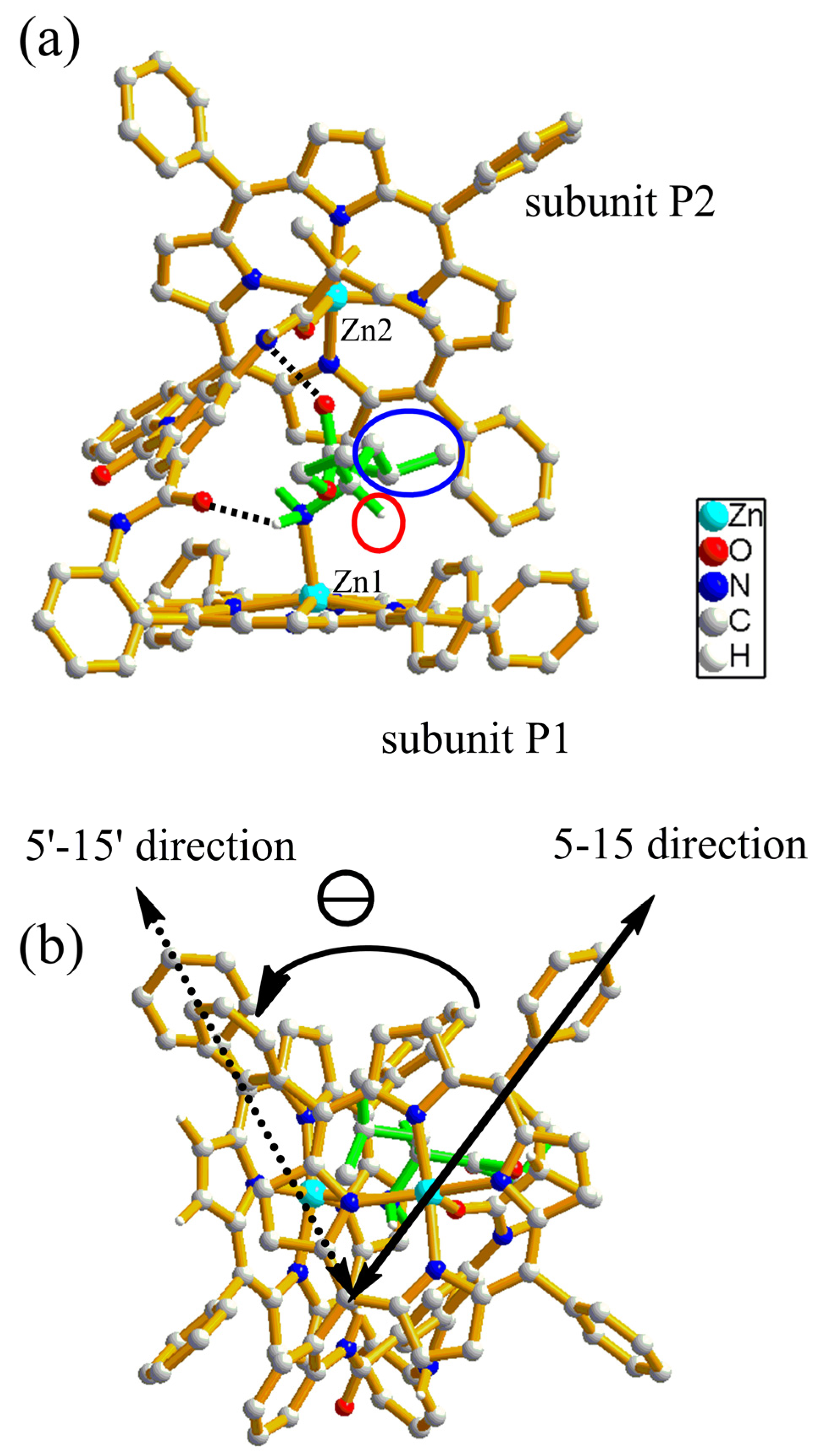
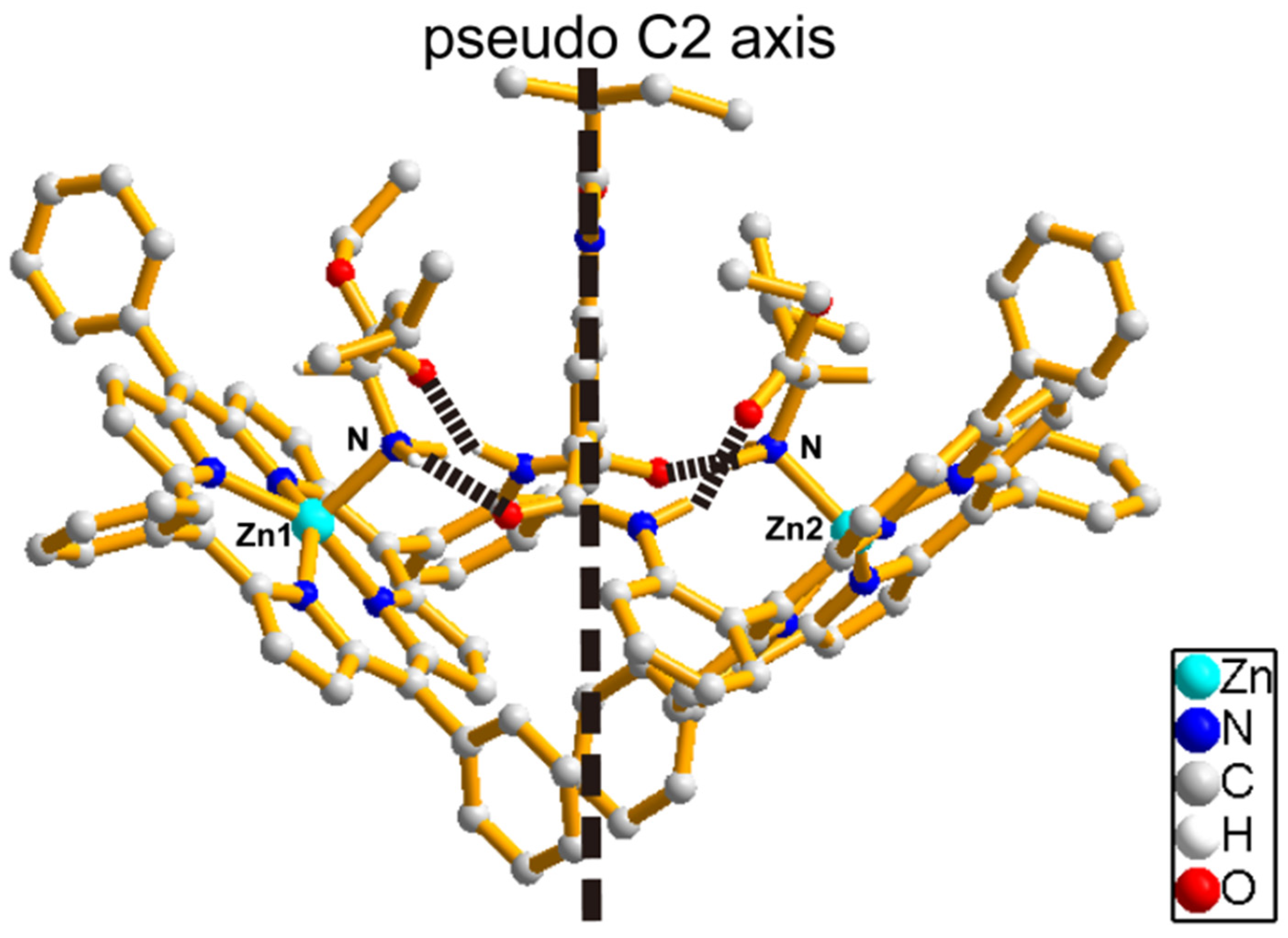
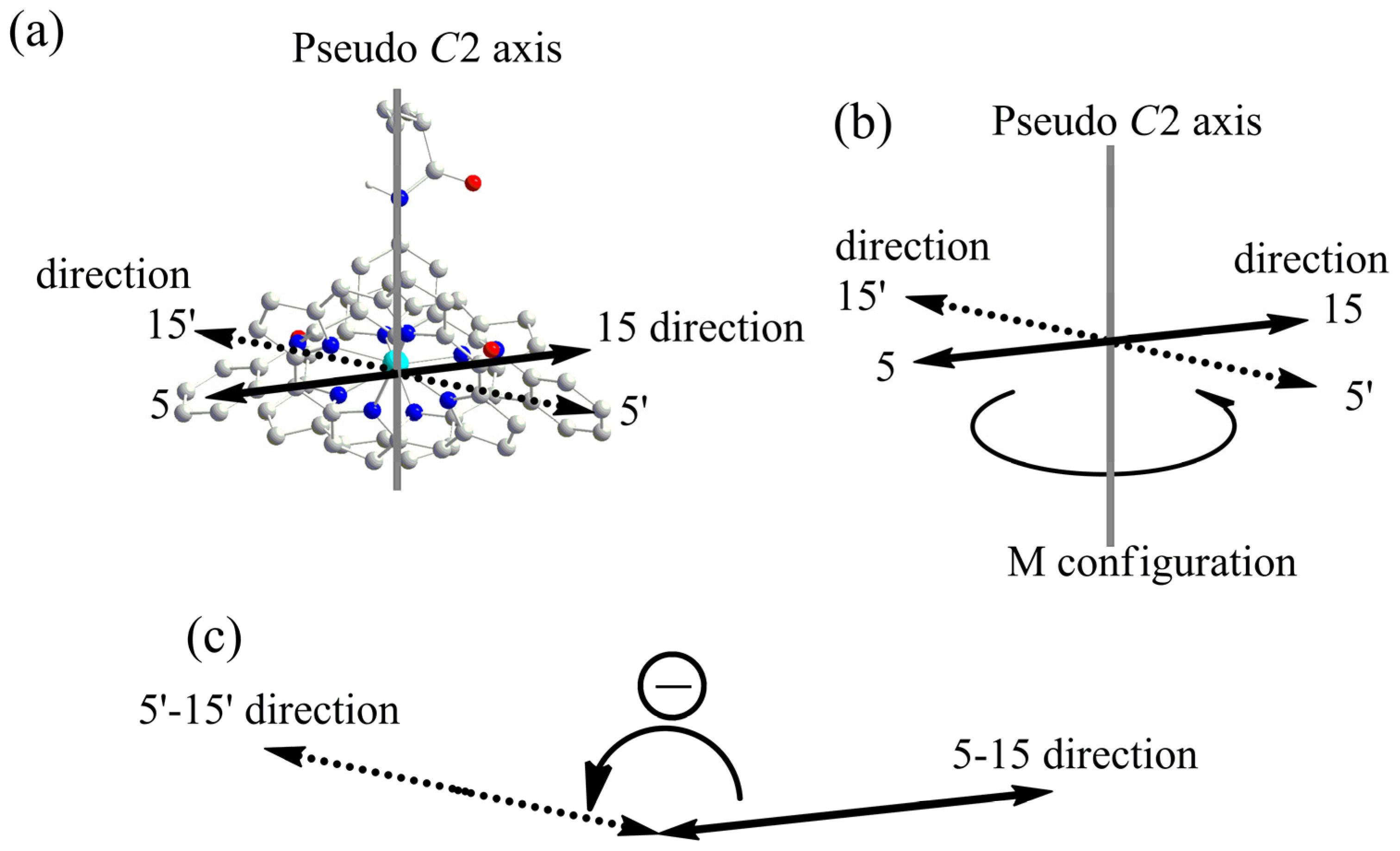
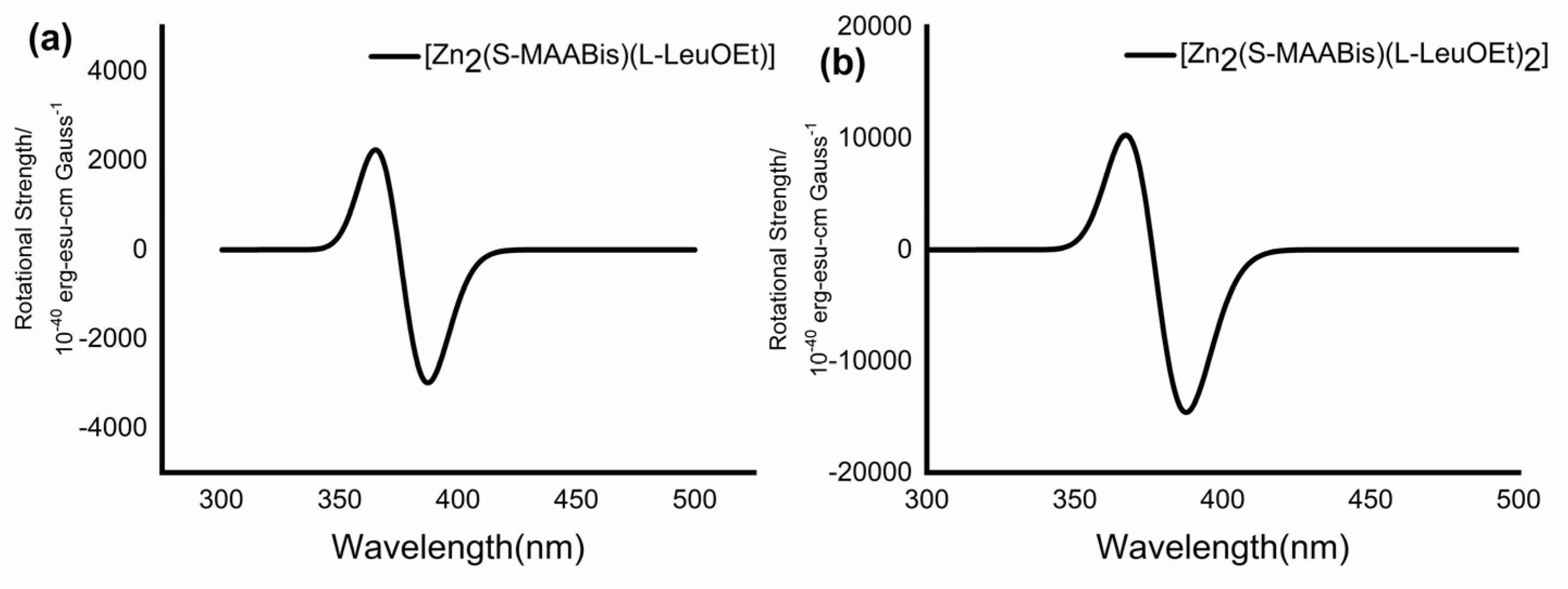
| Amino Acid Esters | [Zn2(S-MAABis)] | Amino Acid Esters | [Zn2(S-MAABis)] | ||
|---|---|---|---|---|---|
| Δε (cm−1M−1), λ (nm) | Aobs a | Δε (cm−1M−1), λ (nm) | Aobs a | ||
| l-LeuOEt | 796, 421 | −1861 | d-LeuOEt | −748, 421 | 1754 |
| −1065, 430 | 1006, 430 | ||||
| l-ValOEt | 996, 421 | −2269 | d-ValOEt | −775, 421 | 1827 |
| −1273, 431 | 1052, 431 | ||||
| l-AlaOEt | 677, 421 | −1475 | d-AlaOEt | −643, 421 | 1480 |
| −798, 430 | 837, 430 | ||||
| l-PhgOEt | 740, 421 | −1726 | d-PhgOEt | −704, 421 | 1646 |
| −986, 431 | 942, 431 | ||||
| l-PheOEt | 932, 421 | −2164 | d-PheOEt | −919, 421 | 2149 |
| −1232, 431 | 1230, 431 | ||||
| K1 | K2 | Kf | α | |
|---|---|---|---|---|
| d-LeuOEt | 8.7 × 104 | 5.8 × 102 | 5.0 × 107 | 0.81 |
| l-LeuOEt | 5.2 × 104 | 1.2 × 103 | 6.2 × 107 | |
| d-ValOEt | 5.2 × 104 | 4.0 × 102 | 2.1 × 107 | 1.9 |
| l-ValOEt | 2.4 × 104 | 4.7 × 102 | 1.1 × 107 | |
| d-AlaOEt | 2.6 × 104 | 1.0 × 103 | 2.6 × 107 | 0.93 |
| l-AlaOEt | 2.9 × 104 | 9.8 × 102 | 2.8 × 107 | |
| d-PhgOEt | 6.4 × 104 | 3.1 × 102 | 2.0 × 107 | 0.74 |
| l-PhgOEt | 3.7 × 104 | 7.2 × 102 | 2.7 × 107 | |
| d-PheOEt | 1.8 × 105 | 3.1 × 102 | 5.6 × 107 | 1.8 |
| l-PheOEt | 9.4 × 104 | 3.3 × 102 | 3.1 × 107 |
| [Zn4(MAABis)2(H2O)] | |
|---|---|
| CCDC number | 2367225 |
| Formula | C202H140N22O7Zn4 |
| Formula weight | 3248.83 |
| Crystal system | monoclinic |
| Space group | P21/n |
| a/Å | 24.5519(19) |
| b/Å | 24.7223(17) |
| c/Å | 33.671(2) |
| α/° | 90 |
| β/° | 104.566(4) |
| γ/° | 90 |
| V/Å3 | 19,781(2) |
| Z | 4 |
| Dc/(g cm−3) | 1.091 |
| F(000) | 6728.0 |
| μ/mm−1 | 0.650 |
| Crystal size/mm3 | 0.12 × 0.1 × 0.09 |
| Radiation/Å | GaKα (λ = 1.34139) |
| 2θ range for data collection/° | 3.492 to 104.194 |
| Index ranges | −28 ≤ h ≤ 28, −28 ≤ k ≤ 29, −23 ≤ l ≤ 39 |
| Reflections collected | 141611 |
| Independent reflections | 33621 [Rint = 0.0824, Rsigma = 0.0884] |
| Data/restraints/parameters | 33621/1631/1906 |
| Goodness-of-fit on F2 | 1.070 |
| Final R indexes [I ≥ 2σ (I)] | R1 = 0.1170, wR2 = 0.2915 |
| Final R indexes [all data] | R1 = 0.2050, wR2 = 0.3375 |
| Largest diff. peak/hole/e Å−3 | 0.59/−0.68 |
Disclaimer/Publisher’s Note: The statements, opinions and data contained in all publications are solely those of the individual author(s) and contributor(s) and not of MDPI and/or the editor(s). MDPI and/or the editor(s) disclaim responsibility for any injury to people or property resulting from any ideas, methods, instructions or products referred to in the content. |
© 2024 by the authors. Licensee MDPI, Basel, Switzerland. This article is an open access article distributed under the terms and conditions of the Creative Commons Attribution (CC BY) license (https://creativecommons.org/licenses/by/4.0/).
Share and Cite
Li, Z.; Zhao, Y.; Wang, Y.; Zhang, W.-H.; Hu, C. Chirality Sensing of Amino Acid Esters by S-2-Methylbutanamido-Substituted m-Phthalic Diamide-Linked Zinc Bisporphyrinate. Molecules 2024, 29, 3652. https://doi.org/10.3390/molecules29153652
Li Z, Zhao Y, Wang Y, Zhang W-H, Hu C. Chirality Sensing of Amino Acid Esters by S-2-Methylbutanamido-Substituted m-Phthalic Diamide-Linked Zinc Bisporphyrinate. Molecules. 2024; 29(15):3652. https://doi.org/10.3390/molecules29153652
Chicago/Turabian StyleLi, Zhipeng, Yue Zhao, Yong Wang, Wen-Hua Zhang, and Chuanjiang Hu. 2024. "Chirality Sensing of Amino Acid Esters by S-2-Methylbutanamido-Substituted m-Phthalic Diamide-Linked Zinc Bisporphyrinate" Molecules 29, no. 15: 3652. https://doi.org/10.3390/molecules29153652





